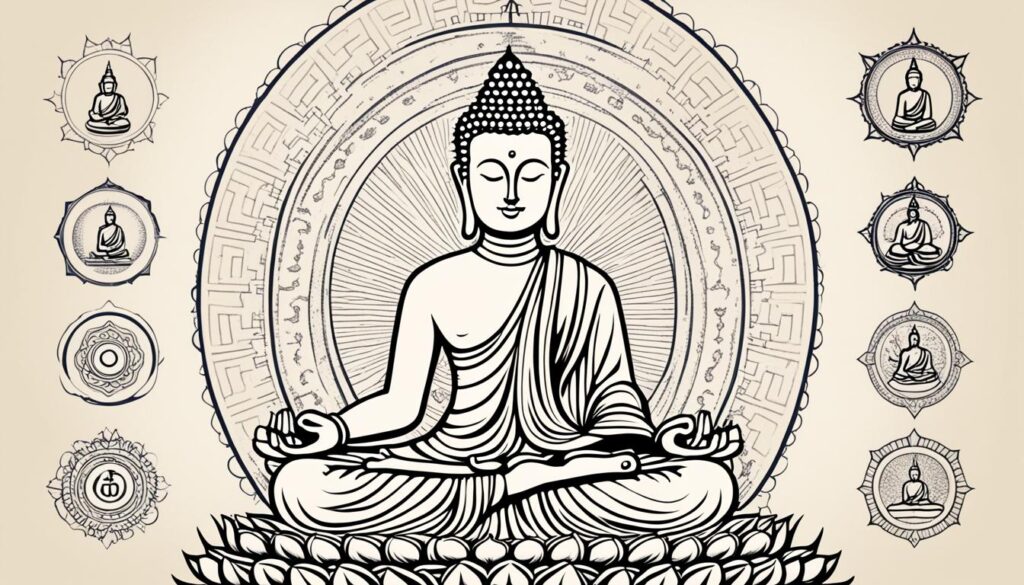Is Buddhism a monotheistic or polytheistic religion? This question has puzzled many, as Buddhism is often categorized alongside other major world religions with well-defined beliefs in gods or a singular deity. But what if Buddhism challenges these conventional notions? What if it offers a unique perspective that transcends the boundaries of polytheism and monotheism? In this article, we delve into the essence of Buddhism and explore its relationship with the concept of divinity.
Key Takeaways:
- Buddhism is a non-theistic religion that does not believe in a supreme being or deities.
- The central figure in Buddhism, the Buddha, was a man who attained enlightenment and is revered as a guide and teacher.
- Buddhism focuses on the teachings and practices that lead individuals to attain enlightenment and liberation from suffering.
- Figures in Buddhist art and temples are representations of enlightened beings, not deities.
- Buddhism emphasizes direct realization and personal experience over blind faith or belief.
Core Teachings of Buddhism
Buddhism is built upon foundational teachings that guide practitioners on the path to enlightenment and liberation from suffering. Central to Buddhism are the Four Noble Truths and the Noble Eightfold Path, which provide a profound understanding of the nature of suffering and the means to transcend it.
Four Noble Truths
- Suffering is an inherent part of human existence
- The cause of suffering is attachment and desire
- The cessation of suffering is attainable
- The Noble Eightfold Path leads to the cessation of suffering
The Four Noble Truths serve as a lens through which practitioners can understand and address suffering in their lives. The Buddha taught that by acknowledging and understanding suffering, individuals can free themselves from its grip and find lasting peace.
Noble Eightfold Path
- Right understanding
- Right thought
- Right speech
- Right action
- Right livelihood
- Right effort
- Right mindfulness
- Right concentration
The Noble Eightfold Path provides a comprehensive framework for transforming one’s life and cultivating the qualities necessary for enlightenment. Each aspect of the path represents a key area of focus, guiding practitioners to develop mindfulness, ethical behavior, and wisdom. By following the Noble Eightfold Path, individuals can walk the path to liberation and find true happiness.
Who are the Figures in Buddhist Art and Temples?
Buddhist art and temples are adorned with various figures that hold significant meaning within the Buddhist tradition. These figures, such as Green Tara, White Tara, Kuan Yin, Manjushri, and Avalokitesvara, play an important role in the practice and symbolism of Buddhism. However, it is essential to understand that these figures are not worshipped as gods or deities, but rather as representations of bodhisattvas.
Bodhisattvas are enlightened beings who have chosen to postpone their own enlightenment in order to assist others on their spiritual journey. They embody compassion, wisdom, and the qualities of a perfected being. Buddhists hold deep respect and gratitude towards bodhisattvas, seeking their guidance and inspiration as they navigate the path towards enlightenment.
Images and statues of bodhisattvas are found in Buddhist temples and art forms worldwide. These visual representations serve as reminders of the virtues and teachings of bodhisattvas. They depict compassion, serenity, and spiritual strength, illuminating the aspirational qualities that practitioners aspire to cultivate within themselves.
Additionally, the presence of statues and images of the Buddha is common in Buddhist temples. These representations of the Buddha serve as focal points for meditation and contemplation. They symbolize the embodiment of enlightenment and offer practitioners a visual reminder of the Buddha’s teachings.
Image:

Through the figures depicted in Buddhist art and temples, practitioners are encouraged to cultivate compassion, wisdom, and a greater understanding of the spiritual path. These representations serve as powerful reminders of the qualities that lead to enlightenment and liberation from suffering.
| Figure | Description |
|---|---|
| Green Tara | A representation of enlightened activity and compassion. |
| White Tara | A symbol of long life, healing, and compassion. |
| Kuan Yin | A bodhisattva associated with compassion and mercy. |
| Manjushri | An embodiment of wisdom and intellect. |
| Avalokitesvara | A bodhisattva representing compassion and infinite kindness. |
Importance of Direct Realization
Buddhism places great emphasis on the importance of direct experience and realization. Rather than relying on blind faith or belief, you are encouraged to directly investigate and test the teachings for yourself. By engaging in personal exploration and inquiry, you have the opportunity to discover profound truths and insights.
In Buddhism, it is believed that every individual possesses the potential for “Buddha consciousness.” This is the awakened state of mind characterized by wisdom, compassion, and profound understanding. It is through direct realization that you can tap into this limitless potential and cultivate these qualities within yourself.
One of the key ways to cultivate direct realization is through the practice of Buddhist meditation. Through meditation, you can quiet the mind, develop mindfulness, and gain insight into the nature of reality. By observing your thoughts, emotions, and sensations with non-judgmental awareness, you can begin to understand the impermanent and interdependent nature of existence.

The Journey of Buddhist Meditation
Buddhist meditation is not merely a relaxation technique, but a transformative practice that can lead you to higher states of consciousness. It involves turning inward and exploring the depths of your own mind. Through sustained practice, you can develop clarity, concentration, and insight.
During meditation, you may encounter various mental states and experiences, ranging from calmness and tranquility to restlessness and resistance. These encounters provide valuable opportunities for self-discovery and growth. By observing these experiences without attachment or aversion, you can develop equanimity and cultivate a sense of inner peace.
Buddhist meditation practices vary across different traditions and schools of Buddhism. Some common forms of meditation include breath awareness, loving-kindness meditation, and insight meditation. Each practice serves as a vehicle for deepening your understanding of the mind and awakening to your true nature.
In summary, direct realization and the cultivation of Buddha consciousness are keys to the essence of Buddhism. Through meditation and inquiry, you can personally experience the profound teachings of Buddhism and uncover your own potential for awakening.
The Buddha as a Teacher
The historical figure known as the Buddha, Siddhartha Gautama, was born in Nepal over 2,500 years ago. Through his own inner journey and dedicated meditation practice, he attained enlightenment and became the awakened one. The Buddha’s teachings, known as Buddhist teachings, provide invaluable insights into the nature of suffering and the path to liberation.
Central to the Buddha’s teachings are the Four Noble Truths, which unveil the reality of suffering in human existence and offer a path for its cessation. These truths invite you to acknowledge suffering, understand its causes, and discover the potential for liberation. Through the Noble Eightfold Path, the Buddha outlined a series of practices that guide individuals towards attaining enlightenment and liberation.

As a teacher, the Buddha emphasized the importance of questioning and direct experience. Instead of relying on blind faith, he encouraged individuals to investigate his teachings and to directly apply them in their own lives. By cultivating wisdom, ethical behavior, and mindfulness, one can deepen their understanding and experience the transformative power of the Buddhist path.
The Four Noble Truths
- The truth of suffering: Recognizing the existence of suffering in life.
- The truth of the cause of suffering: Understanding the craving and attachment that leads to suffering.
- The truth of the cessation of suffering: Realizing that it is possible to be free from suffering.
- The truth of the path leading to the cessation of suffering: Following the Noble Eightfold Path to transcend suffering.
The Noble Eightfold Path
- Right View: Developing a clear understanding of the nature of reality.
- Right Intention: Cultivating wholesome intentions and renouncing harmful ones.
- Right Speech: Practicing truthful, kind, and harmonious communication.
- Right Action: Acting in ways that promote well-being and do not harm others.
- Right Livelihood: Engaging in a livelihood that aligns with ethical principles.
- Right Effort: Cultivating wholesome states of mind and letting go of unwholesome ones.
- Right Mindfulness: Developing present-moment awareness and non-judgmental observation.
- Right Concentration: Cultivating focused and undistracted states of mind through meditation.
The teachings of the Buddha go beyond mere intellectual understanding and invite you to embody the principles of compassion, wisdom, and liberation in your daily life. By following the path he laid out, you can discover profound insights and experience personal transformation.
Sects of Buddhism
Buddhism has evolved into different sects or schools over time. The two main branches are Theravada and Mahayana Buddhism.

Theravada Buddhism is prevalent in Sri Lanka, Cambodia, Thailand, and Burma. It emphasizes the original teachings of the Buddha and focuses on individual liberation. This sect is deeply rooted in the Pali scriptures and encourages the practice of meditation and the pursuit of wisdom. Theravada Buddhists strive to achieve nirvana, the ultimate goal of liberation from suffering, through personal discipline and self-realization.
Mahayana Buddhism is more widespread in Tibet, China, Japan, and Korea. It places an emphasis on the compassionate aspiration to attain enlightenment for the benefit of all beings. Mahayana teachings include the idea of bodhisattvas—enlightened beings who postpone their own liberation to help others. This sect believes in the interconnectedness of all beings and aims to achieve not only personal enlightenment but also the liberation of all sentient beings.
While there are differences between Theravada and Mahayana Buddhism, both share the ultimate goal of awakening and liberation from suffering. The emphasis may differ, with Theravada focusing more on the individual’s path to enlightenment and Mahayana emphasizing the compassionate pursuit of universal liberation. Nonetheless, both sects offer profound teachings and practices that guide individuals on the path to enlightenment.
Exploring Buddhism’s Impact
Buddhism has had a profound impact on both individuals and society as a whole. Its teachings on mindfulness and compassion have permeated various fields, including psychology, medicine, and education.
The Power of Mindfulness
Mindfulness, a practice rooted in Buddhism, has gained widespread popularity due to its ability to alleviate stress, increase focus, and promote overall well-being. By cultivating present-moment awareness and non-judgmental acceptance, mindfulness enables individuals to navigate the challenges of modern life with clarity and resilience.
Compassion in Action
Central to Buddhism is the cultivation of compassion, the deep understanding and empathy for the suffering of oneself and others. This emphasis on compassion has inspired countless individuals to engage in acts of kindness and service, fostering a more harmonious and caring society.
Addressing Modern Challenges
With its practical guidance and profound insights into the nature of existence, Buddhism offers valuable resources for navigating the complexities of the modern world. Its teachings provide tools for self-reflection, personal growth, and finding meaning amidst the fast-paced, often disconnected nature of contemporary life.
Cultivating Personal and Societal Harmony
Buddhism promotes inner peace and harmony, recognizing that true happiness comes from within. By fostering qualities such as patience, equanimity, and gratitude, individuals can create a sense of personal harmony that ripples out into the broader community, nurturing a more compassionate and balanced society.
| Aspect | Main Impact |
|---|---|
| Mindfulness | Alleviates stress, increases focus, promotes well-being |
| Compassion | Inspires acts of kindness and fosters a caring society |
| Practical Guidance | Provides insights and tools for navigating modern challenges |
| Personal Harmony | Cultivates inner peace and happiness |
| Societal Harmony | Contributes to a more compassionate and balanced society |
Conclusion
In exploring the essence of Buddhism, we have come to understand its unique spiritual path, which transcends the traditional categories of polytheism or monotheism. Rather than worshiping deities or a supreme being, Buddhism focuses on the teachings and practices that lead to enlightenment and liberation from suffering. It is a non-theistic religion that encourages individuals to develop their own understanding through direct experience and realization.
Buddhism’s impact extends beyond the realm of spirituality. The development of mindfulness practices, rooted in Buddhist teachings, has had a profound influence on various fields such as psychology, medicine, and education. By cultivating mindfulness, individuals are able to alleviate stress, improve focus, and enhance their overall well-being. Additionally, Buddhism emphasizes the importance of compassion, which has the power to foster personal and societal harmony.
Exploring the essence of Buddhism can provide valuable insights for personal growth and navigating the challenges of the modern world. The teachings of Buddhism offer practical guidance for addressing the complexities of life and finding inner peace. By embracing mindfulness, compassion, and the pursuit of enlightenment, you can embark on a transformative journey that leads to a greater understanding of self and a more meaningful existence.
FAQ
Is Buddhism a monotheistic or polytheistic religion?
No, Buddhism is neither monotheistic nor polytheistic. It is a non-theistic religion, meaning it lacks a belief in a supreme being or deities.
Who is the central figure in Buddhism?
The central figure in Buddhism is Siddhārtha Gautama, also known as the Buddha. He is revered as a teacher and guide.
What are the core teachings of Buddhism?
The core teachings of Buddhism include the Four Noble Truths, which explain the nature of suffering, its causes, and the path to its cessation. The Noble Eightfold Path provides a framework for individuals to cultivate mindfulness, ethical behavior, and wisdom.
Are the figures depicted in Buddhist art and temples considered gods?
No, the figures in Buddhist art and temples, such as Green Tara, White Tara, Kuan Yin, Manjushri, and Avalokitesvara, are not considered gods. They are representations of bodhisattvas, enlightened beings who have chosen to delay their own enlightenment in order to help others.
What is the significance of statues and images of the Buddha?
Statues and images of the Buddha are used as a focal point for meditation and as a reminder of the teachings. They are not worshipped as gods, but rather serve as symbols of enlightenment and liberation from suffering.
How does Buddhism emphasize direct realization?
Buddhism emphasizes the importance of direct experience and realization. Individuals are encouraged to directly investigate and test the teachings for themselves, cultivating mindfulness and inquiry into the nature of consciousness.
Who was Siddhārtha Gautama, the Buddha?
Siddhārtha Gautama was a historical figure born in Nepal over 2,500 years ago. He attained enlightenment through his own inner journey and meditation, becoming the awakened one. The Buddha dedicated his life to teaching others about the nature of suffering and the path to liberation.
What are the main branches of Buddhism?
The main branches of Buddhism are Theravada and Mahayana. Theravada Buddhism is prevalent in Sri Lanka, Cambodia, Thailand, and Burma, focusing on individual liberation. Mahayana Buddhism is more widespread in Tibet, China, Japan, and Korea, emphasizing the compassionate aspiration to attain enlightenment for the benefit of all beings.
What impact has Buddhism had on society?
Buddhism’s teachings on mindfulness and compassion have influenced various fields, including psychology, medicine, and education. Its practices have gained popularity for promoting stress reduction, focus, and overall well-being. Buddhism offers insights and guidance for addressing modern challenges and cultivating personal and societal harmony.
Is Buddhism a monotheistic or polytheistic religion?
No, Buddhism is neither monotheistic nor polytheistic. It is a non-theistic religion focused on the teachings and practices that lead to enlightenment and liberation from suffering.

